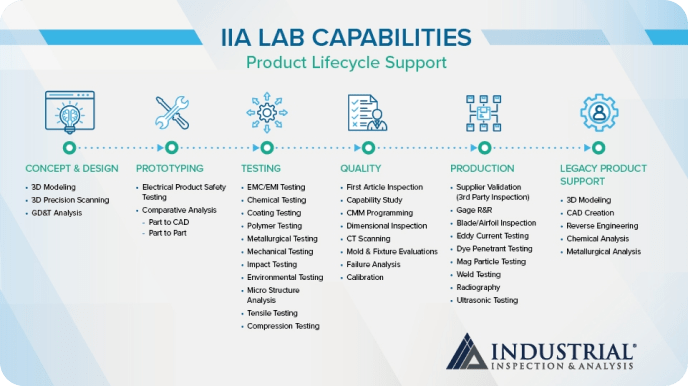IIA lab services is a premier provider of a full range of conventional NDE (non-destructive evaluation) servicesConventional NDE
Conventional NDE

Talk To An Expert
Don’t see exactly what you are looking for? Or maybe you do and want more specifics or an estimate. Either way, you can call us at
470-264-5765
right now or just fill out the form below and we will respond back within 24 hours.
DYE PENETRANT (PT)
This widely applied and low-cost inspection method is used to locate surface-breaking defects in all non-porous materials, such as metals, plastics, or ceramics. PT is used to detect casting, forging and welding surface defects such as hairline cracks, surface porosity, leaks in new products, and fatigue cracks on in-service components. IIA is capable of performing all types and methods of penetrant inspection.
MAGNETIC PARTICLE (MT)
Magnetic particle inspection (MT or MPI) is an inspection method for locating surface or shallow sub-surface defects on ferromagnetic material, such as castings, forgings, welds and machined parts. IIA can perform both wet and dry MPI methods. There is essentially no limit to the size and shape of parts that can be inspected using MT.
RADIOGRAPHY (RT)
For welds, castings and parts used in high stress or high reliability environments, radiographic testing is a highly accurate method to detect internal defects not apparent on the surface of the part. Conventional radiography using gamma sources is a popular method of non-destructive testing in numerous industries due to its proven accuracy, cost effectiveness, high level of portability, and extreme flexibility. We perform x-ray/gamma ray/radar inspection – both film and digital – to MIL-SPEC, ANSI, ASTM and ASME specifications. This is often performed in conjunction with penetrant or magnetic particle inspection for surface coverage. IIA can inspect practical thickness ranges up to 3.0” steel.
ULTRASONICS (UT)
Ultrasonic testing is a suite of methodologies that detect a variety of indications or characterize materials by transmitting high-frequency sound waves through a test item into a receiver. Depending on how the sound waves travel through the object, determinations can be made about the material condition and structural integrity of the object. One common use is ultrasonic thickness testing (UTT), which measures the thickness of the test object to determine the extent of corrosion. IIA performs both contact and immersive UT, with capabilities for pulse echo, transmissional, straight beam, angle beam (shear wave) testing, as well as advanced phased array techniques.

VISUAL TESTING (VT)
With an eye for detail, our highly trained and certified inspectors will visually inspect for indications such as cracks, corrosion, erosion, damage, and overall structural integrity of equipment such as tanks, steam turbines, fans, pressure vessels, piping, lift equipment and more.
Certifications and Guidelines
- ASNT SNT-TC-1A
- ASNT CP-189
- NAS410
- ISO 9001:2015
- ISO 17025:2017
- ITAR Registered
- Permit to Practice Professional Engineering from Northwest Territories and Nunavut
- Association of Professional Engineers and Geoscientists
- Certificate of Authorization from the Association of Professional Engineers and Geoscientists of the Province of Manitoba
- FFL – Federal Firearms License
- Canadian Standards Association (CSA) W178.1
- Certificate of Authorization to Perform Engineering Services in Ontario - Professional Engineers of Ontario (PEO) Canadian Welding Bureau (CWB)
- Professional Engineers and Geoscientists Newfoundland and Labrador Permit to Practice
- Certificate of Compliance from the Association of Professional Engineers of Nova Scotia
- Permit to Practice from the Association of Professional Engineers and Geoscientists of Alberta
- FAA Certification #NI2R032L
